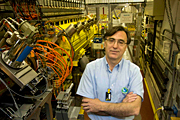- Number 313 |
- June 7, 2010
Testing targets for producing steady neutrino beams

Nick Simos, coordinator of
BNL’s experiment, at BLIP.
While neutrinos are among the most abundant particles in the universe, they rarely interact with other matter. They are often described as “ghost” particles and, in many ways, they are just as mysterious.
Neutrinos are created through nuclear reactions such as those powering the sun and other stars but much about them is still unknown. For the past several months, scientists at Brookhaven National Laboratory (BNL) on Long Island have been conducting experiments on potential materials for producing neutrino beams artificially here on Earth as part of the Long Baseline Neutrino Experiment (LBNE), a project funded by the Department of Energy’s Office of Science. The plan is for the world’s highest-intensity neutrino beam to be produced at Fermi National Accelerator Laboratory (Fermilab) and sent more than 1,000 kilometers through the Earth to detectors at the proposed Deep Underground Science and Engineering Laboratory (DUSEL) in South Dakota. From measurements at these detectors, scientists hope to learn more about the three known types of neutrinos and how they oscillate, or change, from one type to another.
To create the extraordinarily high-intensity beam of neutrinos, scientists propose bombarding a resilient target with bunches of highly energetic protons under extreme conditions. The Brookhaven Linac Isotope Producer (BLIP), primarily used to produce medical isotopes, can recreate the anticipated conditions and consequently the proton-induced effects on the target’s material structure. By assessing an array of such materials, scientists can see which are best at withstanding the extreme operating conditions while producing neutrino beams and establish their useful operational life, which will help ensure that no unexpected failure of the target will interrupt beam production.
Teams from BNL and Fermilab have been working together to design and execute the BLIP experiment using the 180-million-electron-volt Linac beam. They began their experiments on March 18 and expect to be wrapping up as this issue goes online.
For more information on the LBNE, visit http://lbne.fnal.gov/
Submitted by DOE's Brookhaven National Laboratory
